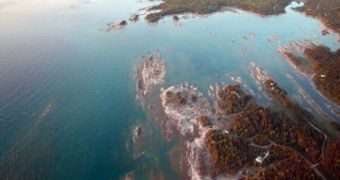More than 9,000 years ago, the stony ridges underneath Lake Huron were land bridges connecting the territories of what are now Canada and the United States. Currently buried under 100 feet (33 meters) of water, they provided archaeologists with the first ever clues that proved beyond the shadow of a doubt that the area housed human settlements in the past. Investigators from the University of Michigan discovered under the waves what appeared to be caribou-hunting buildings, as well as traces of settlements belonging to the early hunters.
“This is the first time we've identified structures like these on the lake bottom. Scientifically, it's important because the entire ancient landscape has been preserved and has not been modified by farming, or modern development. That has implications for ecology, archeology and environmental modeling,” UM Department of Anthropology Professor John O'Shea, who is also the Museum of Anthropology Great Lakes Archeology curator and the co-author of a new study on the finds, says.
The paper, which appears in the June 8th issue of the Proceedings of the National Academy of Sciences, is also co-authored by Marine Hydrodynamics Laboratories Director Guy Meadows. The latter is a professor in the departments of Naval Architecture and Marine Engineering, and Atmospheric, Oceanic and Space Sciences at UM. The two found under the water a caribou hunting lane, which is basically a long path that narrows down progressively and is bordered with natural obstacles, to force the animals into ambushes.
The 1,148-foot structure they found under Lake Huron closely resembles a similar formation, discovered on Victoria Island, in the Canadian subarctic. The hunting lane was found on the 10-mile-wide Alpena-Amberley ridge, which stretches from Point Clark, Ontario, to Presque Isle, Michigan, for over 100 miles. The archeology team says that the find is of pristine quality, as no later developments were made on the ground, as is often the case with important cultural sites.
“The combination of [...] state-of-the art tools have made these underwater archological [sic.] investigations possible. Without any one of these advanced tools, this discovery would not have happened,” Meadows said of the sonar equipment and underwater remote-operated vehicles that the team used for the surveys. “Without the archaeological sites from this intermediate time period, you can't tell how they got from point A to point B, or Paleo-Indian to Archaic. This is why the discovery of sites preserved beneath the lakes is so significant,” O'Shea concluded.

 14 DAY TRIAL //
14 DAY TRIAL //